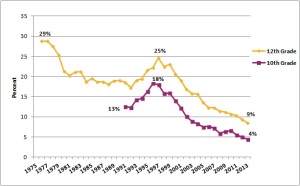Tag Archives: problems
Push for No More Tobacco
From http://www.hhs.gov./
Source: Johnston, L. D., O’Malley, P. M., Bachman, J. G., & Schulenberg, J. E. (2014). Monitoring the Future national survey results on adolescent drug use, 1975-2013: Volume I, Secondary school students. Ann Arbor: Institute for Social Research, The University of Michigan.
Over the last 40 years, the use of tobacco has steadily decreased due to many enforcement of laws, regulations, government and local support, and established health awareness programs. But the concern is now focused on teens and adults who are still buying and using tobacco in different forms. Once someone has used tobacco, they could eventually or become immediately addicted to nicotine.
So what are the trends of using tobacco besides smoking tobacco:
- Oral tobacco products that dissolves in the user’s mouth; they still contain tobacco properties that puts the user’s health at risk and they can come in different forms and flavors.
- Hookah is a mouth piece smoking pipe that is commonly popular among teens and is used among groups where they pass it on to each other. Not only is it not sanitary of bodily fluids, it is technically like smoking a cigarette where the toxins are released and inhaled into the body.
- Smokeless tobacco is in the form where tobacco can be sniffed and chewed. “For smokeless tobacco use, the highest rates of initiation are in the seventh through 11th grades. Although approximately equal proportions of male and female adolescents smoke cigarettes, users of smokeless tobacco products are nearly all males.” – http://www.hhs.gov/
- E-cigarette is a cigarette that can be used electronically to vaporized a liquid that gives off the feeling that one is smoking tobacco. Although e-cigarettes has no tobacco, they still contain nicotine.
Sometimes, people don’t understand the consequences of using tobacco. The fact that tobacco was scientifically proven to lead to other cancer diseases and cause the user to have other health related problems is already a concern. We can’t stop the production of tobacco, but at least try to educate the public what tobacco can do to the body.
- Increases the risk of almost every organ disease such as the mouth, bladder, stomach, lung, heart, kidney, and more.
- Worsen asthma symptoms
- Nicotine is scientifically proven to be a addictive stimulant and can cause people to rely on it for temporarily relaxation
- Affects the body’s sexual, thyroid, pituitary, and adrenal hormones
- Affects the production and sensitivity of insulin that could lead to type 2 diabetes and other potential health issues
- Trying to quit smoking tobacco can cause physical reactions such as strong cravings for the substance, an increased appetite, insomnia and sleep disturbances, gastrointestinal problems and mood-related complaints including anxiety, anger and frustration, depression, irritability and restlessness. – [source: MayoClinic]” – http://science.howstuffworks.com
So before using tobacco in any way of any form, think about how it could affect you, your body, and your health in the long term.


